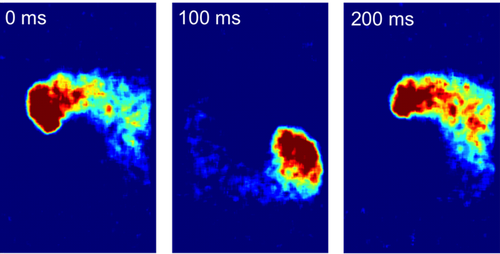Biological Cells Form Electric Circuits
The human heartbeat is produced by electrical pulses that propagate through cardiac tissue, causing rhythmic muscle contraction. Researchers have previously engineered cells to create an artificial tissue capable of producing coordinated electrical activity, and now a team has added the ability to monitor their electrical state by detecting fluorescent emission. They have also fashioned the cells into “living circuits” that might act as model systems for studying heart behavior.
Constructing electrically active tissues from their basic building blocks by genetically engineering cells allows researchers to study a “clean” system similar to the more complicated cardiac tissue. These systems let them investigate, for example, the electrical signals that lead to the potentially fatal irregular heartbeat called arrhythmia. Previously researchers have introduced ion channels—proteins that conduct ions through cell membranes—into human kidney cells to make electrically “excitable” tissues [1]. Adam E. Cohen of Harvard University and his co-workers decided to add more ingredients to such cells, so that the electrical activity could be light-activated and easily visualized.
They incorporated four additional gene products into human embryonic kidney (HEK) cells. Two were ordinary ion channels; the other two were a blue-light-activated ion channel (a light-sensitive switch) and a protein that fluoresces with an intensity that depends on the voltage across the membrane in which it is embedded.
Light activation of electrically excitable cells has been shown before [2]. But Cohen and colleagues have now included a convenient “readout” mechanism (the fluorescent protein) and have used patterning methods to shape the cell cultures into “tissue circuits.” They grew rings of cells a few millimeters in diameter that could act as oscillators that support circulating waves of electrical excitation. These waves arise from the collective behavior of the cells: a pulse produced by one cell can trigger another from its neighbors, eventually producing a coherent wave of excitation traveling through the tissue. It’s this coordination, in a repeating cycle of excitation and quiescence, that gives rise to rhythmic activity in cardiac tissue.
The ring of engineered HEK cells acted like an electronic “ring oscillator,” a device with a characteristic frequency to its circulating electrical signal. The electrical waves in a ring oscillator can propagate in either direction around the ring, enabling it to serve as a binary memory unit. Cohen and colleagues found that in their HEK tissues, these circulating waves remained stable for more than two hours, with the pulses completing a few circuits every second. The electrical signals were easily visualized as waves of fluorescent emission.
The researchers say that these tissues could be used to understand and predict the behavior of real cardiac cells, especially arrhythmias. “In real heart, if you pace the tissue fast enough, it starts skipping beats and eventually becomes arrhythmic,” says Cohen. This state is a well-known precursor to sudden cardiac death and is associated with the breakup of the usual regular waves of electrical excitation. Some drugs also have the dangerous side effect of inducing arrhythmia, and Cohen says that the new system might offer a quick and convenient way of screening for such hazards.
The work “is really very elegant and deserves attention,” says physiologist Gil Bub of Oxford University in the UK. “It opens new research questions for people like me who are interested in wave dynamics in excitable systems.”
There might also be practical uses for information processing in living tissues. “By combining patterns of cell growth and patterns of ion channel expression, we think we can build diodes, amplifiers, and other simple logic elements,” says Cohen. Andrew Adamatzky of the University of the West of England in Bristol, a specialist in “unconventional computing,” foresees circuits that perform computations through the interactions of electrical waves. “This research might lead to fabrication of implantable bio-computers,” he says.
This research is published in Physical Review X.
–Philip Ball
Philip Ball is a freelance science writer in London. His latest book is How Life Works (Picador, 2024).
References
- R. D. Kirkton and N. Bursac, “Engineering Biosynthetic Excitable Tissues from Unexcitable Cells for Electrophysiological and Cell Therapy Studies,” Nature Commun. 2, 300 (2011).
- R. D. Kirkton and N. Bursac, “Genetic Engineering of Somatic Cells to Study and Improve Cardiac Function,” Europace 14, Suppl. 5, v40 (2012).





